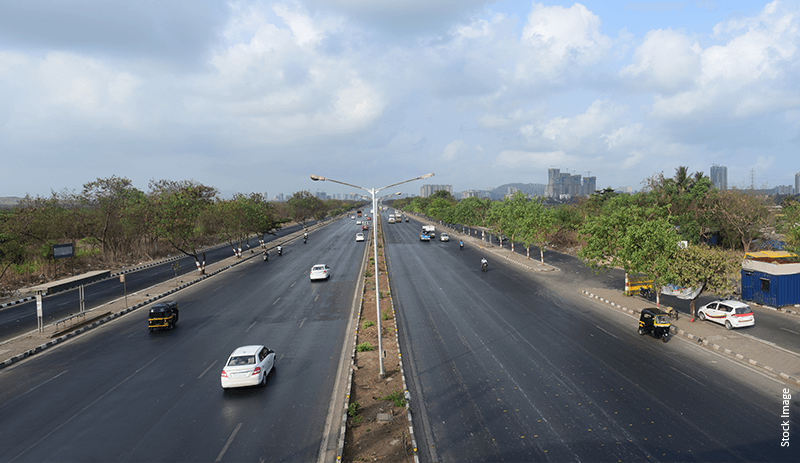31 May, 2023
4 mins read

Mumbai, the maximum city, is one of the significant contributors to India's GDP. The island city, in recent years, has seen a tremendous infrastructure boom which will only elevate in the upcoming years. These infrastructure projects will give Mumbai a facelift and further increase economic growth in the city. The Mumbai Metros Navi Mumbai International Airport, Coastal Road Project, and Mumbai Trans Harbour Project are to name a few. However, currently, some highways in the city act as the backbone to connect various parts of the city. The Eastern Express Highway and the Eastern Freeway are two such highways that ease travelling for a regular Mumbaikar.
The Eastern Express Highway in Mumbai, also known as EEH, is a 23.55km long highway starting at Chhatrapati Shivaji Maharaj Terminus and connecting all the major suburbs of North Mumbai to it. The eastern highway comprises 6 lanes and links to National Highway 3. The Sion-Panvel Highway cuts the Eastern Express Highway at the RCF junction (Priyadarshini) and then links it to the city's surrounding areas. There it is commonly referred to as Dr Ambedkar Road. The Mumbai Metropolitan Region Development Authority (MMRDA) is responsible for regularly undertaking several improvement and maintenance measures for the expressway. The eastern highway acts as an artery of Mumbai, connecting the island city to the eastern suburbs and the metropolitan area of Thane. Being one of the busiest routes in the Mumbai Metropolitan, the Eastern Express Highway route it experiences heavy traffic during rush hours. Similar to Eastern Express Highway, there also exists the Western Express Highway, which also runs from the north to south direction of the city. In some areas, both these highways are parallel to one another. It is important to note that both projects have greatly reduced the burden of traffic congestion on other roadways and areas.
Eastern Freeway, officially known as the Vilasrao Deshmukh Eastern Freeway, is a highway in Mumbai that spans 16.8km. This high-speed, controlled-access highway stretches from Orange Gate near P D Mello Road to Eastern Express highway in Ghatkopar. The Eastern Freeway in Mumbai was built by the Mumbai Metropolitan Region Development Authority (MMRDA) and financed by the Central Government under the Jawaharlal Nehru National Urban Renewal Mission (JnNURM). The freeway has 9 entry-exit ramps and is also equipped with seismic arresters that can even bear earthquakes up to 7.5 on the Richter scale. This is meant to be a safety measure since a large number of vehicles regularly ply the freeway all through the day and even in the late hours of the night. The success of the freeway has made MMRDA inclined towards planning the extension of the same. The planned extension of 14 km would take place from Ghatkopar to Thane with four more entry-exit ramps.
| Eastern Freeway entry and exit | Type of ramp |
|---|---|
| Orange Gate near P D Mello Road | Entry and Exit |
| Port Road near Nawab Tank & Dockyard Road | Exit only |
| Reay Road, near Port Road and Mahul Road | Entry only |
| Sewri Station | Entry and Exit |
| Bhakti Park | Entry and Exit |
| Mysore Colony and RCF Junction | Entry and Exit |
| Shivaji Chowk, Panjarpol | Entry and Exit |
| Govandi | Entry and Exit |
| Ghatkopar – Mankhurd Link Road | Entry and Exit |
The maximum speed limit allowed on the freeway is 80km/h. Therefore, only two-wheelers, four-wheelers and other public modes of transport commonly used by people to travel can comfortably ply on the freeway which is yet another factor that reduces traffic congestion to a great extent.
Improved connectively due to upcoming infrastructure projects has always has a positive impact on the real-estate market, especially when it comes to the residential sector. These infrastructure projects have not only reduced the travelling time for Mumbaikars to a great extent but also have helped scale the value proposition of the real estate properties in these areas. For example, the localities closer to the entry or exit ramps of the freeway, like the Orange Gate or Anik Junction, have seen considerable price appreciation in the last few years. When the planned extension and construction of the freeway is complete, the areas surrounding the route are likely to see increased residential development activity, better amenities, and an overall improvement in the connectivity from one part of the city to another
Infrastructure projects like the Eastern Express Highway and Eastern Freeway have improved connectivity, reduced the traffic burden from the existing roads, reduced the time taken from travelling, and enhanced the value proposition of Mumbai. For residents of Piramal Aranya the connectivity and accessibility from South Mumbai to other parts of the city are crucial variables that can help them save more time and effort during their work commute. With lower traffic congestion, the reduced travelling time to and from their workplace means enjoying all the comforts of their home and rejuvenating in their personal space without any hassles!
Disclaimer- This article is based on the information publicly available for general use as well as reference links mentioned herein. We do not claim any responsibility regarding the genuineness of the same. The information provided herein does not, and is not intended to, constitute legal advice; instead, it is for general informational purposes only. We expressly disclaim /disown any liability, which may arise due to any decision taken by any person/s basis the article hereof. Readers should obtain separate advice with respect to any particular information provided herein.
13 December, 2023
05 June, 2023